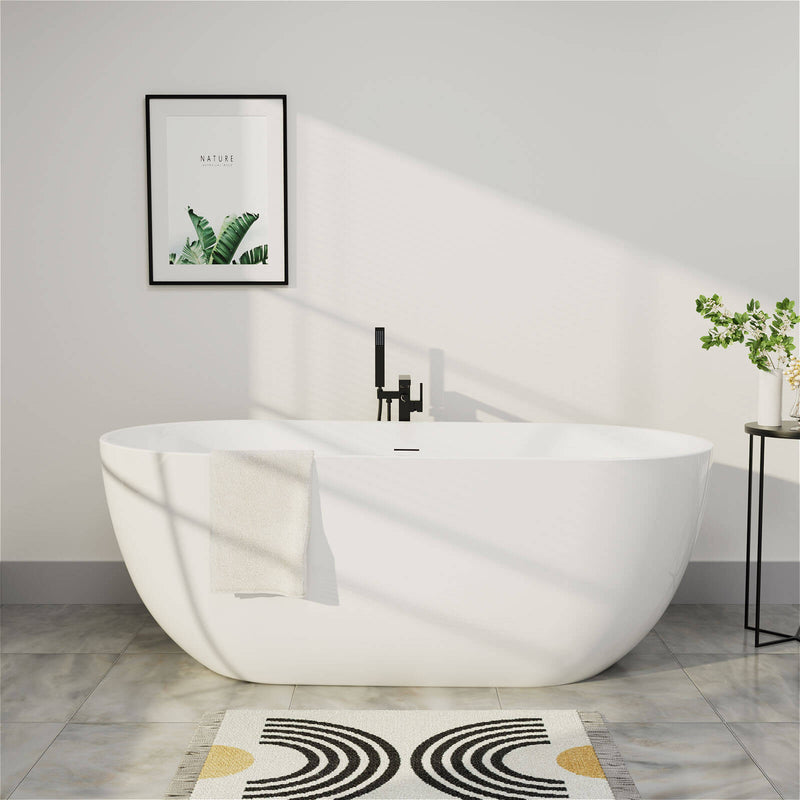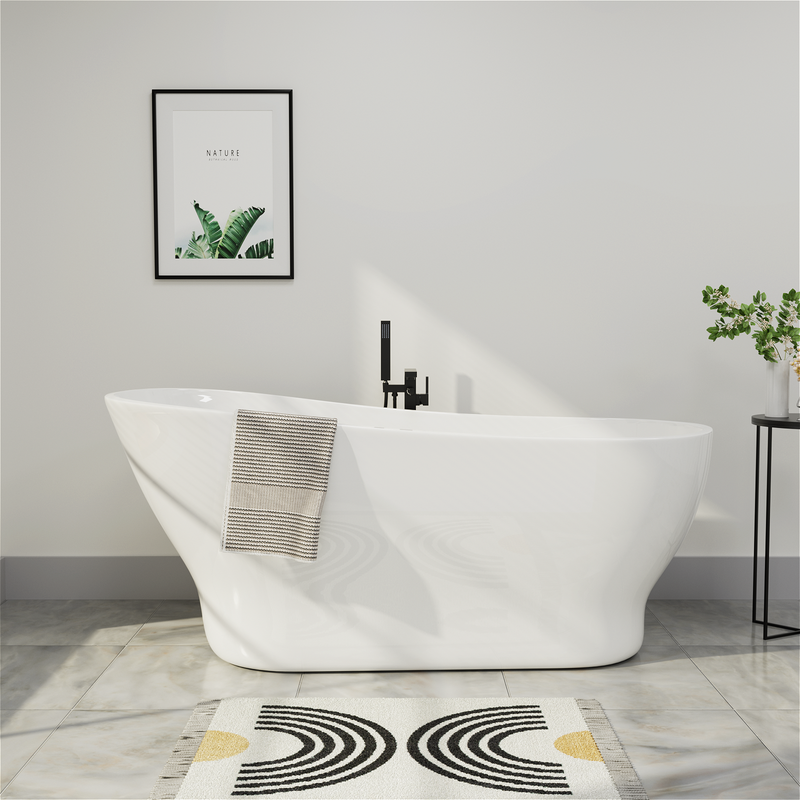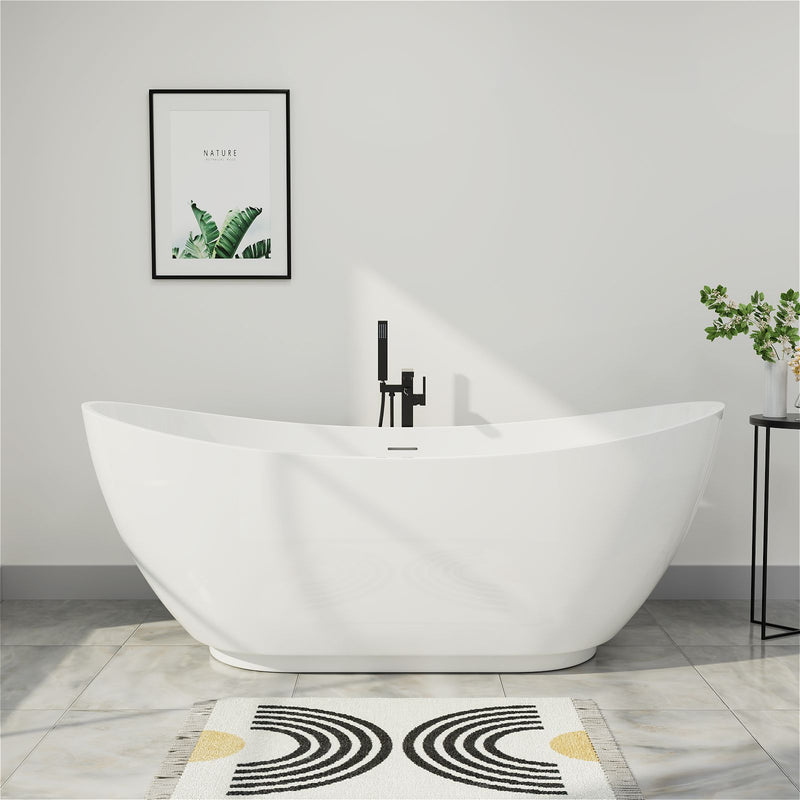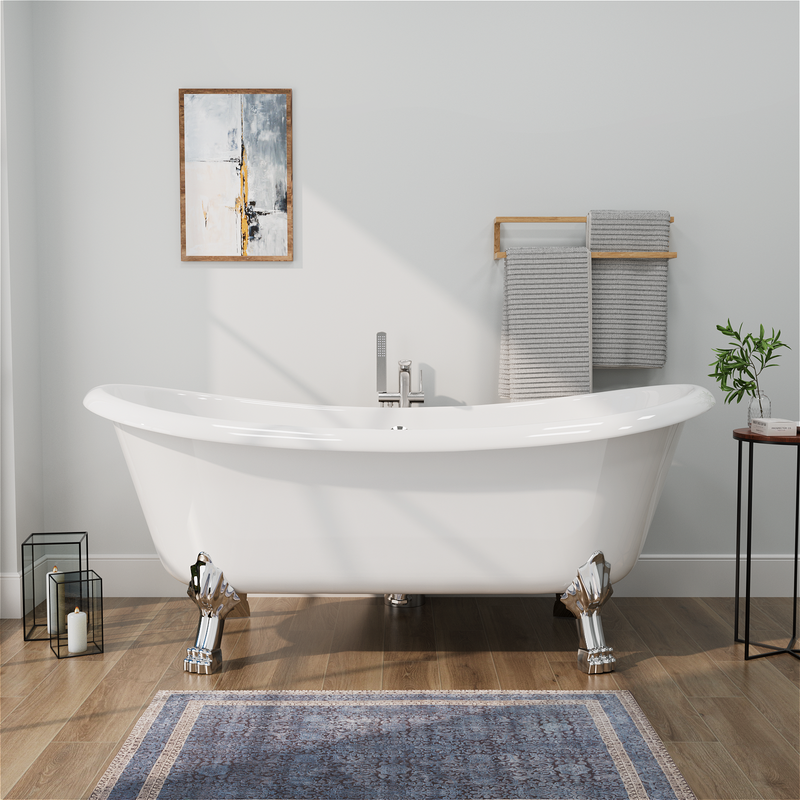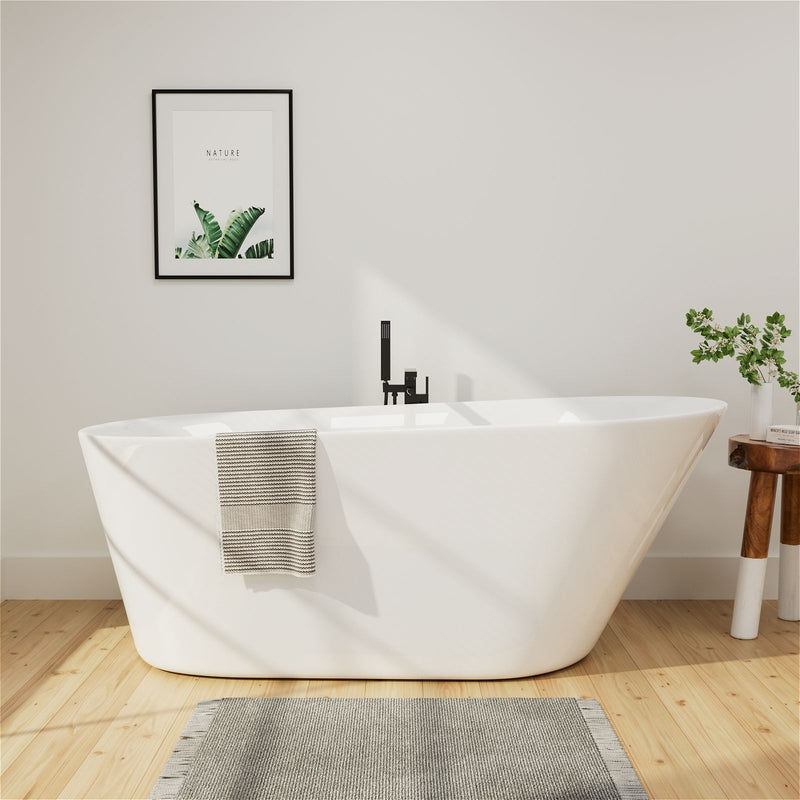Knowing what your tub is made of can help with everything from cleaning to renovating. Whether you're planning on replacing your tub or just want to learn how to care for it, learning to tell what your tub is made of is a useful skill. So, let's take a deep dive into the different types of tub materials and how to identify them!
Common Types of Tub Materials
It can be overwhelming to explore the vast array of tub materials available. Being familiar with the various materials and knowing what you want will not only make your tub selection easier, but it will also ensure you get the right style that will enhance your bathing experience and fit your budget. Here are some pros and cons of some common materials to help you choose the best option for your bathroom.

Fiberglass
Fiberglass is a reinforced plastic that is formed in layers, then molded into the shape of the tub and finally coated with a gel coat of resin. Fiberglass is a lightweight option, and they often have a textured surface that can feel slightly rough to the touch. If your tub has a more matte finish and feels slightly warmer to the touch than a metal tub, it's probably made of fiberglass. This material is often more affordable, but keep in mind that it may become less durable over time.
Advantages
Very affordable, fiberglass bathtubs are perfect for those on a tight budget. They are also easy to move and install around the house due to the light weight of the material used, and any damage can be easily repaired.
Disadvantages
Fiberglass is also perhaps the most brittle material on the market. It is porous and will regularly absorb water, making it prone to cracking. The color and finish will also deteriorate over time due to the use of common cleaning equipment. The material is also prone to "bending", causing it to lose its shape and feel unstable.
Acrylic
Acrylic is a solid sheet that is made from a combination of materials such as petrochemicals, stabilizers, resins, fillers, and suitable dyes, which is then heated and molded into the shape of the bathtub and finally reinforced with fiberglass. Acrylic is usually smooth and fine, and feels silky to the touch. Tap it gently and you will hear a hollow sound, which is a distinct characteristic of acrylic material.
Advantages
Firstly, unlike regular fiberglass, it is a non-porous material, so it will not absorb any excess water, which means it will retain its shine, never mold, and is easy to repair. Besides that, it also retains the heat of the water and prevents mold or general bathroom stains. In addition, this tub is available in a wide variety of designs.
Disadvantages
Acrylic tubs are pricier than fiberglass tubs, but they are prone to scratching if cleaned too vigorously. Like fiberglass tubs, acrylic tubs also bend, which makes the tub less stable when standing. Depending on the formulation, most acrylic tubs will yellow over time.
Stone Resin/Artificial Stone
Stone resin is a material used to mimic the look of natural stone. These tubs are usually more modern in design and are made from a high-quality composite material with a hard surface. These tubs have a drain and overflow system built into the walls, making them easy to install without any exposed drain pipes.
Advantages
Like most resins, it will not fade after repeated use. The material is non-porous, which means it does not absorb water and retains water temperature very well. It has a very long lifespan and does not require frequent repairs, and even if it needs to be discarded, Stone Resin is 100% recyclable. Stone Resin is also seen as a more luxurious bathtub material, not to mention that the material itself is very durable and can withstand heavy wear and tear. Cleaning is also simple. Most stains and mold can be removed with just warm water, while some stubborn residues can be removed with a mild abrasive. Overall, Stone Resin is the most cost-effective bathtub material.
Disadvantages
Although Stone Resin may be more expensive than acrylic or fiberglass, it is durable and can save you a lot of trouble.

Enameled Steel
Enameled steel bathtubs are a classic. They have a smooth and hard surface and are very beautiful. However, if you knock on the side of the bathtub, you will hear a metallic sound, which is a big help! These bathtubs are heavier and may be more troublesome to install, but they are known for their durability.
Advantages
The steel substrate with high-temperature enamel coating is highly impact-resistant and not easy to crack or deform. The surface is hard and scratch-resistant than acrylic. Steel has a high thermal conductivity and initially dissipates heat quickly, but modern products use a multi-layer enamel process, which has significantly improved thermal insulation. Easy to clean and maintain, strong chemical resistance, and safe to use chlorine-containing cleaners.
Disadvantages
Very heavy, requires reinforced floor slabs to bear the weight, and is expensive to transport and install. Sound conduction is obvious, and it is noisy when filling with water, so it needs to be installed with noise-proof pads. Difficult to repair, and professional high-temperature re-firing is required after the glaze is damaged, which is expensive to repair. Tiny cracks may cause the "porcelain chipping effect" (the surrounding glaze continues to fall off).
Cast Iron
Molten iron is poured directly into the bathtub mold, which is then smoothed and finally coated with a layer of porcelain enamel. This bathtub is a high-end choice and is durable. If you have a cast iron bathtub, you can tell its weight at first glance - these bathtubs are heavy! They are thick and solid, and usually have an enamel coating. The surface can be smooth or textured, and it will produce a deep and resonant sound when tapped with a tap. Although it is more laborious to install, they have a very long service life.
Advantages
Cast iron bathtubs are perhaps the most durable bathtubs on the market. Because of its sturdy material, it is very resistant to scratches and chips, which means it is also easier to clean. Speaking of cleaning, most mold (if not all) can be washed away with just warm water and baking soda. If a stronger cleaner is needed, a mild one can be used, but this rarely happens. Also, cast iron bathtubs retain heat well, which means your bathtub will stay warmer for longer.
Disadvantages
Durability also means weight. Cast iron bathtubs are very heavy, and are probably the heaviest bathtubs currently available. Therefore, you must give extra consideration to the support structure around your house and the bathtub before installing it. You also have to bear a high price considering the materials involved and the extra work required to support the surrounding space. The porcelain on the surface is actually very slippery. In addition, the designs of this type of bathtub are also quite limited.
Wood
Natural wood brings a unique bathing experience. If you have a sufficient budget, choose cypress or teak. If you are looking for cost-effectiveness, consider cedar or carbonized pine. Wood wax oil should be applied regularly for daily maintenance.
Advantages
Beautiful and elegant, it brings a natural and sincere texture. In addition, because wood is easy to process, wooden bathtubs can be made into various shapes and sizes according to your preferences and add a touch of luxury to your bathing time.
Disadvantages
Luxury also comes at a high price, because wood is often in contact with water, which means that your bathtub will have a shorter lifespan compared to almost all other types of bathtubs on the market. In addition, there are special factors that must be considered in your home to accommodate wooden bathtubs, such as space and frames. Cost is also a big reason why wooden bathtubs are not very popular. In addition to the initial cost of a tub, regular maintenance is necessary to ensure the longevity of the tub. Overuse can wash away its durable seal and accelerate wood decay, while underuse can dry out the wood and speed up the decay process. Overall, owning a wooden tub is a rather hassle-free experience.
Visual and Tactile Indicators
Surface Texture

Acrylic Tubs: Super smooth with a shiny finish that is easy to clean and maintain.
Fiberglass Tubs: Slightly rough texture that is more likely to trap soap scum.
Porcelain Enamel Tub: Hard, shiny surface that resembles glass; easy to wipe.
Cast Iron Tubs: Tough, heavy texture with a textured finish that is often a bit cool to the touch.
Stone Tubs: Ranging from polished smooth to rough and rustic, showing natural patterns and imperfections.
Weight
Acrylic or Fiberglass Tubs: Lightweight and easier to install.
Cast Iron Tubs: Very heavy, giving a solid, reassuring feel in the bathroom.
Stone Tubs: Also heavy, emphasizing luxury and durability.
Porcelain Enamel Tub: Somewhere in between - solid, but not as heavy as cast iron or stone.
Colors and Finishes
Acrylic Tub: Bright colors with a nice glossy finish.
Fiberglass Tub: Often available in a variety of colors, but generally a matte finish.
Porcelain Enamel Tub: Classic white finish, usually glossy, giving a fresh, clean look.
Cast Iron Tub: May be white, but with a more matte finish, adding a vintage feel.
Stone Tub: Showcases natural color variations and textures, each one unique and full of character.
Testing Methods
Scratch Test
The scratch test is a great way to identify a tub. Use a sharp object to gently scratch an inconspicuous area.
If it scratches easily, it's most likely fiberglass.
If the surface remains intact, then you're probably looking at porcelain or cast iron.
Magnet Test
For metal tubs, grab a magnet.
If it sticks, you have a steel tub (porcelain enamel or cast iron).
If it doesn't stick, your tub is most likely acrylic or fiberglass.
Water Test
Simple and effective! Pour some water on the surface.
If the water beads up and rolls off, it’s probably acrylic or fiberglass (non-porous).
If the water spreads and soaks through, you probably have a stone tub (porous).
Heat Test
If you’re unsure, try the heat test. Run hot water in the tub and feel the surface.
If the tub feels warm to the touch, it’s most likely acrylic or fiberglass.
If it stays warm for a long time, you’re probably dealing with cast iron or porcelain.
How to Choose a Tub Material?
Choosing the right tub material really comes down to your lifestyle and personal preferences. Here are some key factors to consider:

Durability: Think about how long you want your tub to last. If you’re looking for something sturdy and durable, cast iron or enameled tubs are classic choices.
Maintenance: Some materials require more maintenance than others. If you want a low-maintenance material, acrylic or fiberglass might be a good choice.
Weight and Installation: Do you want a lightweight tub for easy installation? In that case, acrylic or fiberglass are your best choices.
Style: If you're going for a timeless look, cast iron and porcelain enamel tubs have a timeless appeal.
By weighing these factors, you can find a tub material that perfectly matches your needs and preferences!
Maintenance Considerations
Cleaning Tips for Different Materials
Each tub material has its own specific cleaning methods. For acrylic tubs, use a mild detergent and a soft cloth. For fiberglass tubs, use a non-abrasive cleaner to prevent scratches. For porcelain and cast iron tubs, use strong detergents, but be careful not to damage the surface. Tubs made of stone require a pH-balanced cleaner to keep them looking great.
Repair vs. Replacement
When repairing, consider the material. Minor scratches on acrylic can usually be repaired with polishing, while fiberglass may require a patch kit. With porcelain or cast iron, chips can usually be repaired, but severe damage may require replacement.
Frequently Asked Questions About Bathtub Material
Q: What's the best tub material?
A: The best tub material depends on your needs. Comparing tub materials can help you weigh the pros and cons of materials like acrylic, fiberglass, cast iron, and enamel when choosing a new tub.
Acrylic and fiberglass are ideal for lightweight, low-maintenance options. Cast iron and enamel offer durability and timeless beauty. Stone is also a good choice if you're looking for luxury. Consider durability, maintenance, and style to find the best fit for you!
Q: What bathtubs are the most durable?
A: Cast iron and stone are among the most durable materials and can last for decades with proper care.
Q: How do I care for my acrylic bathtub?
A: Use a mild detergent and a soft cloth. Avoid using abrasive scrubbers to keep the surface scratch-free.
Q: Is a cast iron bathtub worth the investment?
A: Of course! While cast iron bathtubs are heavier and more expensive, they offer unmatched durability and classic appeal.
Q: Can I paint a fiberglass bathtub?
A: Yes, but be sure to use a paint specifically designed for fiberglass to ensure good adhesion and durability.
Q: How do I prevent my enamel bathtub from getting scratched?
A: Avoid using abrasive cleaners and tools. Wipe regularly with a soft cloth to keep your bathtub as clean as new!

